Accessibility
Inclusive design is design for all.
The Museum was built to feature inclusive design and sets a global example for accessibility. From the way you enter the building to the way you interact with exhibits, we’ve designed the experience to be inclusive and accessible for everyone.
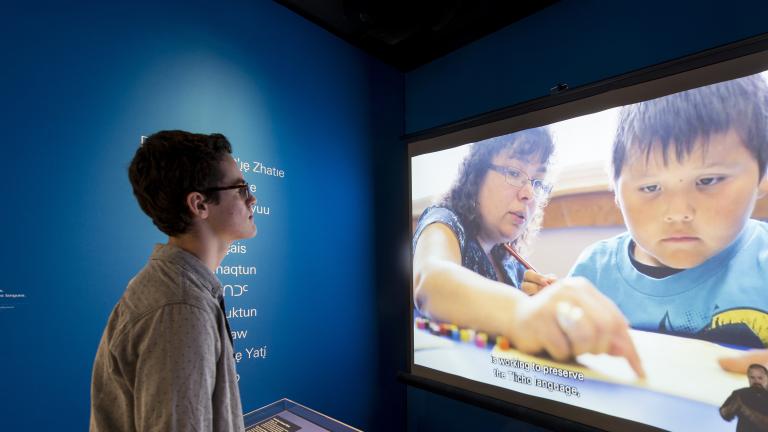
Photo: CMHR, Ian McCausland
Page Navigation
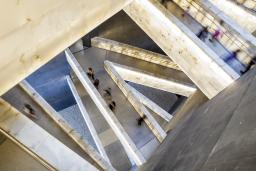
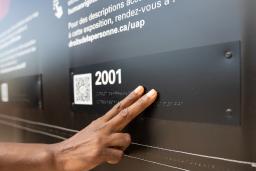
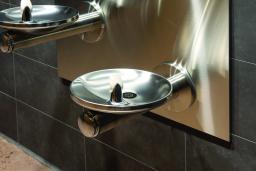
Parking
The Accessible Drop‐off Entrance has four parking stalls and brings visitors right to the doors of the Museum. Additional accessible parking can be found along Israel Asper Way.
Entrances
All Museum entrances are accessible to people using wheeled devices and people who prefer to avoid stairs. An Accessible Drop‐off Entrance allows passengers to be dropped off in close proximity to entry doors.
Inclusive washrooms
All Museum washrooms are gender‐inclusive. There are many available on every gallery level. This includes at least one large, accessible, gender‐inclusive, barrier‐free, single‐room washroom on levels 1, 2, 3, 5, 6 and 7. The single‐room washroom behind the Coat Room area on Level 1 is equipped with an adult‐sized change table and motorized transfer lift; all other single‐room washrooms contain baby change tables.
More information
As of May 17, 2022, all Museum washrooms are gender‐inclusive. We no longer have men’s and women’s washrooms. Instead, information about amenities in each washroom is available to make a choice accordingly. All single‐occupancy washrooms remain available.
This decision is rooted in our work to be a place where everyone is respected and welcomed, including transgender people, those of genders and gender expressions that don’t align with the binary categories of “man” and “woman”, as well as caregivers and families. It’s also one of the ways we are moving forward with our Creating an equitable museum framework.
The process of updating our washrooms is as follows:
- Phase one: change all washroom signs to include non‐gendered icons. The new signage details the fixtures available in each washroom, using icons and braille. Washrooms that contain a urinal display a urinal icon. All washrooms have menstrual products available free of charge as well as disposal units. Phase one was implemented at the end of May 2022.
- Phase two: undertake a space assessment to determine what physical changes may be needed. Necessary changes could include building stalls around the urinals with privacy panels that extend from the floor to the ceiling. As well, the assessment will determine whether the building code allows an extension of the privacy panels for all toilet stalls. The assessment will be completed in the 2022–23 fiscal year and any physical changes would follow.
Elevators
An elevator located in Bonnie & John Buhler Hall stops at all gallery levels, from levels 2 through 7. The Tower Elevator serves Level 3 through Level 8, where the Israel Asper Tower of Hope viewing platform is located.
Strollers
Strollers are available from Coat Check on a first‐come, first‐served basis.
Mobility Aids
The Museum has a small fleet of scooters, power mobility devices and wheelchairs available for pre‐booking or on a first‐come, first‐served basis. Manual wheelchairs can be borrowed at Coat Check.
To book other devices, please contact the Museum:
Phone: 204–289-2000
Toll‐free: 1–877-877 6037
TTY: 204–289‑2050
info@humanrights.ca
Ramps
All galleries can be accessed through a series of inclined ramps with resting spots at regular intervals.
Support persons
Some visitors may require assistance to experience all that the Museum has to offer and may be accompanied by a support person, such as an intervenor, attendant or care provider. Admission is free for the support person.
Service animals
Service animals such as guide dogs and hearing dogs are welcome.
Cane/seats
Foldable, portable cane‐seats are available to borrow at the Level 1 Coat Check.
Telephones
A pay phone located near the Coat Check is TTY capable.
Our mobile app
We offer a fully accessible self‐guided museum tour through our free mobile app. You can use the Museum’s free Wi‐Fi to download the app to your iOS or Android device, or borrow an iPod from the Ticket and Information desk at the Main Entrance.
You can also download the app before your visit to take a virtual tour and learn about the spaces you’d like to explore. It is available in English, French, American Sign Language (ASL) and Langue des signes québécoise (LSQ).
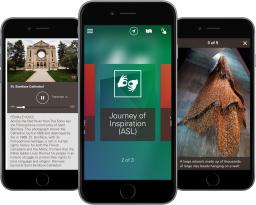
App download links
Audio guide
An audio guide – including the voices of Museum staff members – describes each gallery and provides highlights of exhibits and architecture. Text‐based transcripts can also be viewed. Images and video are used to create a rich, interactive experience.
“Near me” mode
This feature connects your device to over 120 Universal Access Points (UAPs) located throughout the Museum. This feature has been designed to assist visitors who are blind or have low vision, but can be used by all visitors to learn key exhibition highlights. This is the first time this type of technology has ever been used in a Canadian cultural institution.
Sign language
For visitors who are Deaf or hard of hearing, the app can be viewed in ASL or LSQ and includes additional sign‐language content for several exhibitions.
Interactive map
A fully accessible interactive map of the Museum’s public spaces can help you find your way. The map can tell you where you are, show you the floorplans, or guide you to your destination with text‐based directions.
In the galleries
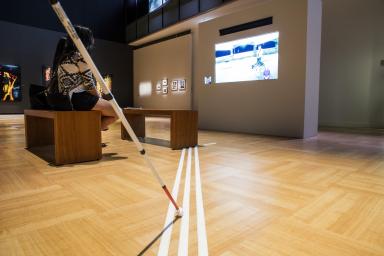
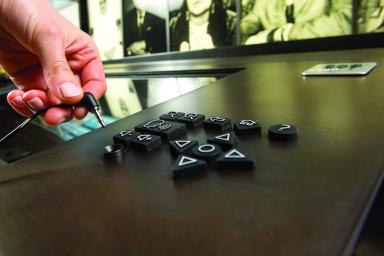
Universal access points
All static exhibition content, as well as audio tours, can be accessed through a tactile marker called a Universal Access Point (UAP). UAPs are located intuitively throughout exhibit areas. These markers can be found on walls and exhibit panels, and are indicated on the floor through the use of a tactile floor strip near to the exhibit. The markers are digitally‐enabled by a device carried by the visitor and consist of raised numbers and Braille codes that trigger audio. For more information, our staff can help you when you visit the Museum.
Universal keypad
Near every touch screen interface is a Universal Keypad. The Universal Keypad (UKP) allows visitors to experience the digital content in touch screen interfaces through accessible tactile controls and voiced instructions. We have two types of UKPs, an Interactive UKP and an Audio UKP.
Interactive UKPs
Interactive UKPs are located near every touch screen interface. This type of UKP allows visitors to access the full functionality of the Museum’s interactive exhibits. It provides:
- Basic volume controls
- Access to descriptive audio tracks through headphones plugged into an audio jack
- A directional keypad for menu navigation, and provides zoom functionality
Audio UKPs
Audio UKPs are located in theatre benches, and at video monitors that are not navigable. They are indicated on the floor through the use of a tactile floor strip near each exhibit. They provide:
- Basic volume controls
- Access to descriptive audio tracks through headphones plugged into an audio jack
More in-gallery features
.jpg?itok=lhCIg7Lm)

.jpg?itok=xuE0Pi9v)
ASL/LSQ
All videos with spoken words (excluding music lyrics) are interpreted via ASL and LSQ on screen. It is important to note that the signers on the screen are not interpreters of ASL/LSQ, but members of the Deaf community. For some exhibits, the ASL and LSQ is delivered through the mobile app.
Braille
A Braille Gallery Guide is available upon request at the Ticketing and Information desk. This guide contains tactile maps of the galleries and English and French Braille. In addition, Braille is used on all Museum Universal Access Points to provide a code for use with the Museum’s mobile app.
Typography and print sizes
All of the exhibits adhere to strict graphic standards to ensure content is as accessible as possible. The exhibit fonts were chosen for maximum legibility and clarity. Type sizes, placement, and even small details such as paragraph alignment and line‐lengths were considered to make content easier to read.
Contrast
Colour contrast and Light Reflectance Value contrasts were designed to ensure sufficient contrast between the text and background to make text easier to read with different lighting conditions or visual impairments.
Descriptive audio
Our videos contain descriptive audio, using a narrator to read out loud on‐screen text, as well as to give a description of what is happening on screen.
Automated voice dubbing
This features uses descriptive audio as a means of dialogue and narration translation. Automated Voice Dubbing allows visitors to understand what is being said, even if the video is not originally in their first language of English and/or French.
Closed captioning
All videos with spoken words (excluding music lyrics) will have closed captioning in both English and French.
Seating
All of our theaters and exhibitions with seating offer a choice of bench seating and seating with backs and arms.
Accessibility concerns in the Museum or online
Have you noticed something that needs to be fixed or improved?
Use the buttons below to report your concerns, or contact us at info@humanrights.ca.
Accessibility Plan
Under the Accessible Canada Act (ACA), we have provided a framework to identify and eliminate barriers to accessibility in order to prevent and actively address discrimination against persons with disabilities.
This plan captures accessibility at the CMHR today and our way forward: work we have done, work we are doing, and work we intend to do. We will review and update this plan often and do so in the spirit of consultation and collaboration.
Tours
Our guided tours are a great way to discover more. We offer tours six days a week, in a 60‐minute express tour or a 90‐minute journey, and we do our best to accommodate any special needs.
Plan your visit
From the hundreds of captivating stories to the stunning architecture both inside and out, there’s so much to explore at the Museum. Make the most of your experience by planning your visit today.